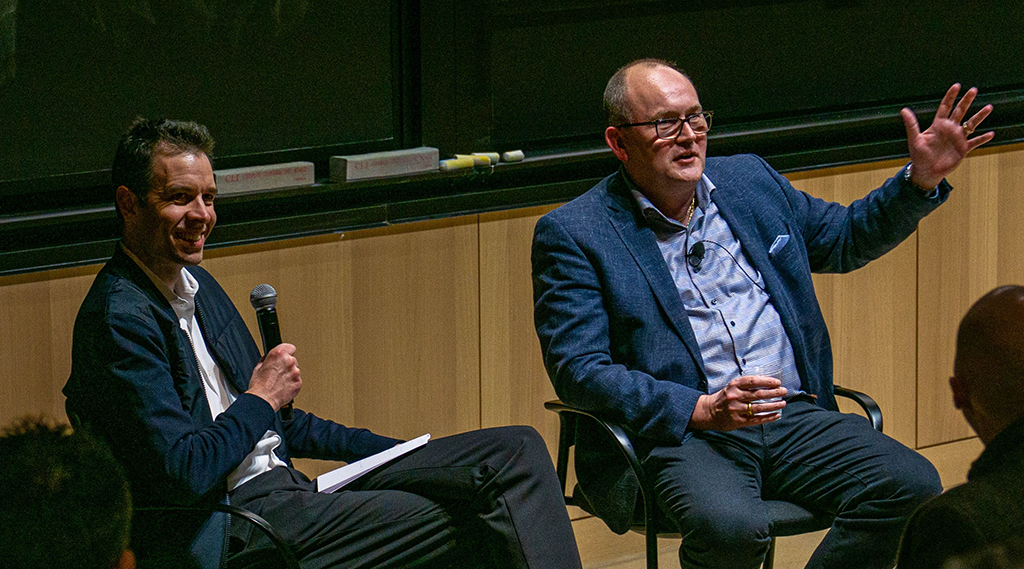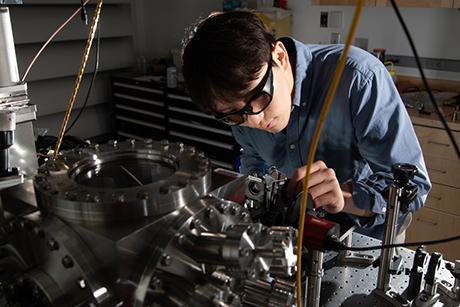LEGO Group COO discusses the production network that enables the builders of tomorrow
Speaking at MIT, the LEGO Group COO Carsten Rasmussen discussed the company’s manufacturing footprint, and the importance of balancing innovation, cost efficiency, and sustainability.
LEGOs are no stranger to many members of the MIT community. Faculty, staff, and students, alike, have developed a love of building and mechanics while playing with the familiar plastic bricks. In just a few hours, a heap of bricks can become a house, or a ship, or an airplane. The simplicity lends itself to creativity and ingenuity, and it has inspired MIT faculty to bring LEGOs into the classroom, including 2.S00 (Introduction to Manufacturing), where students use LEGO bricks to learn about manufacturing processes and systems.
 The LEGO Group COO Carsten Rasmussen discussed the importance of balancing cost efficiency, innovation, and sustainability in manufacturing. Credit: Jeff Dieffenbach
The LEGO Group COO Carsten Rasmussen discussed the importance of balancing cost efficiency, innovation, and sustainability in manufacturing. Credit: Jeff Dieffenbach It was perhaps no surprise then that the lecture hall in the Schwarzman College of Computing was packed with students, faculty, staff, and guests to hear Carsten Rasmussen, chief operating officer of the LEGO Group, speak as part of the Manufacturing@MIT Distinguished Speaker Series. In his engaging and inspiring talk, Rasmussen asked one of the most important questions in manufacturing: How do you balance innovation with sustainability while keeping a complex global supply chain running smoothly? He emphasized that success in modern manufacturing isn’t just about cutting costs – it’s about creating value across the entire network, and integrating every aspect of the business.
Successful manufacturing is all about balance
The way the toy industry views success is evolving, Rasmussen shared. In the past, focusing on “cost, quality, safety, delivery, and service” may have been enough, but today’s landscape is far more demanding. “Now, it’s about availability, customers’ happiness, and innovation,” he said.
Rasmussen, who has been with the LEGO Group since 2001, started as a buyer before moving to various leadership roles within the organization. Today, he oversees the LEGO Group’s operations strategy, including manufacturing and supply chain planning, quality, engineering, and sales and operations planning.
“The way we can inspire the builders of tomorrow is basically, whatever we develop, we are able to produce, and we are able to sell,” he said.
The LEGO Group’s operations are intricate. Focusing on areas such as capacity and infrastructure, network utilization, A&D and sustainability, keeps the company true to its mission, “to inspire and develop the builders of tomorrow.” Within the organization, departments operate with a focus on how their decisions will impact the rest of the company. To do this, they need to communicate effectively.
Intuition and experience play a big role in effective decision-making
In a time where data analytics is a huge part of decision-making in manufacturing and supply-chain management, Rasmussen highlighted the importance of blending data with intuition and experience.
“Many of the decisions you have to make are very, very complex,” he explained. “A lot of the data you’re going to provide me is based on history. And what happened in history is not what you’re facing right now. So, you need to really be able to take great data and blend that with your intuition and your experience to make a decision.”
This shift reflects a broader trend in industries where leaders are beginning to see the benefits of looking beyond purely data-driven decision-making. With global supply chains disrupted by unforeseen events like the COVID-19 pandemic, there’s growing acknowledgement that historical data may not be the most effective way to predict the future. Rasmussen said that the audience should practice blending their own intuition and experience with data by asking themselves, “Does it make sense? Does it feel right?”
Prioritizing sustainability
Rasmussen also highlighted the LEGO Group’s ambitious sustainability goals, signaling that innovation cannot come at the expense of environmental responsibility. “There is no excuse for us to not leave a better planet for the next generation, for the next hundred years,” he said.
With an ambition to make its products from more renewable or recycled materials by 2032 and eliminating single-use packaging, the company aims to lead a shift in trends in manufacturing toward being more environmentally-friendly, including an effort to turn waste into bricks.
Innovation doesn’t exist in a vacuum
Throughout his talk, Rasmussen underscored the importance of innovation. The only way to stay on top is to be constantly thinking of new ideas, he said.
“Are you daring to put new products into the market?” he asked, adding that it’s not enough to come up with a novel product or approach. How its implementation will work within the system is essential, too. “Our challenge that you need to help me with,” he said to the audience, “is how can we bring in innovation, because we can’t stand still either. We also need to be fit for the future…that is actually one of our bigger challenges.”
He reminded the audience that innovation is not a linear path. It involves risk, some failure, and continuous evolution. “Resilience is absolutely key,” he said.
Q&A
After his presentation, Rasmussen sat down with Prof. John Hart for a brief Q&A followed by audience questions. Among the questions that Hart asked Rasmussen was how he would respond to a designer who presented a model of MIT-themed LEGO set, assuring Rasmussen it would break sales records. “Oh, I’ve heard that so many times,” Rasmussen laughed.
Hart asked what it would take to turn an idea into reality. “How long does it take from bricks to having it on my doorstep?” he asked.
“Typically, a new product takes between 12 to 18 months from idea to when we put it out on the market,” said Rasmussen, explaining that the process requires a good deal of integration and that there is a lot of planning to make sure that new ideas can be implemented across the organization.
Then the microphone was opened up to the crowd. The first audience questions came from Emerson Linville-Engler, the youngest audience member at just five years old, who wanted to know what the most difficult LEGO set to make was (the Technic round connector pieces), as well as Rasmussen’s favorite LEGO set (complex builds, like buildings or Technic models).
Other questions showcased how much LEGO inspired the audience. One member asked Rasmussen if it ever got old being told that he worked for a company that inspires the inner child? “No. It motivates me every single day when you meet them,” he said.
Through the Q&A the audience was also able to ask more about the manufacturing process from ideas to execution, as well as whether Rasmussen was threatened by imitators (he welcomes healthy competition, but not direct copycats), and whether the LEGO Group plans on bringing back some old favorites (they are discussing whether to bring back old sets, but there are no set plans to at this time).
For the aspiring manufacturing leaders and innovators in the room, the lesson of Rasmussen’s talk was clear: Success isn’t just about making the right decision, it’s about understanding the entire system, having the courage to innovate, and being resilient enough to navigate unexpected challenges.
The event was hosted by the Manufacturing@MIT Working Group as part of the Manufacturing@MIT Distinguished Speaker Series. Past speakers include the TSMC founder Morris Chang, Office of Science and Technology Policy Director Arati Prabhakar, Under Secretary of Defense for Research and Engineering Heidi Shyu, and Governor of Pennsylvania Tom Wolf.

